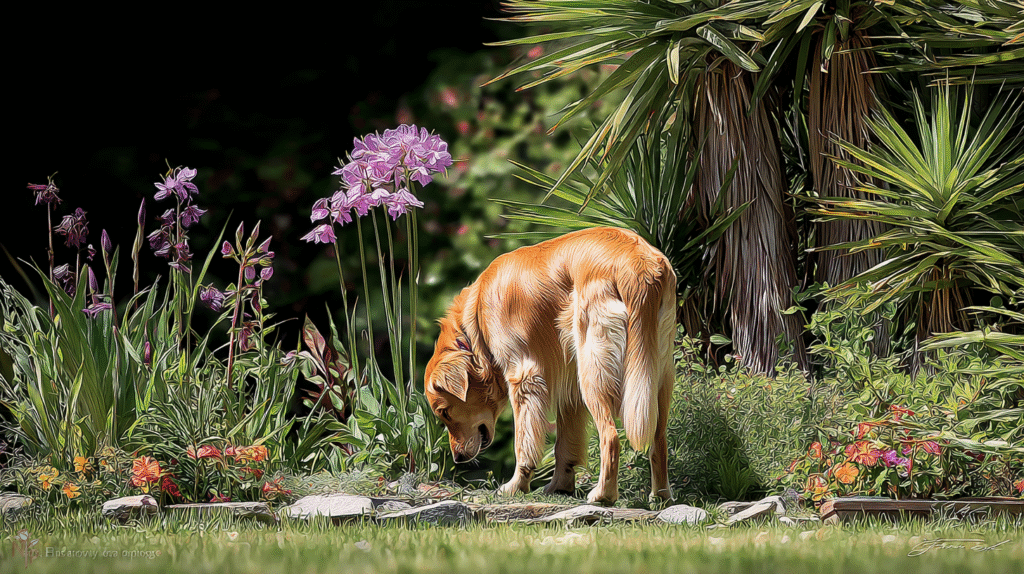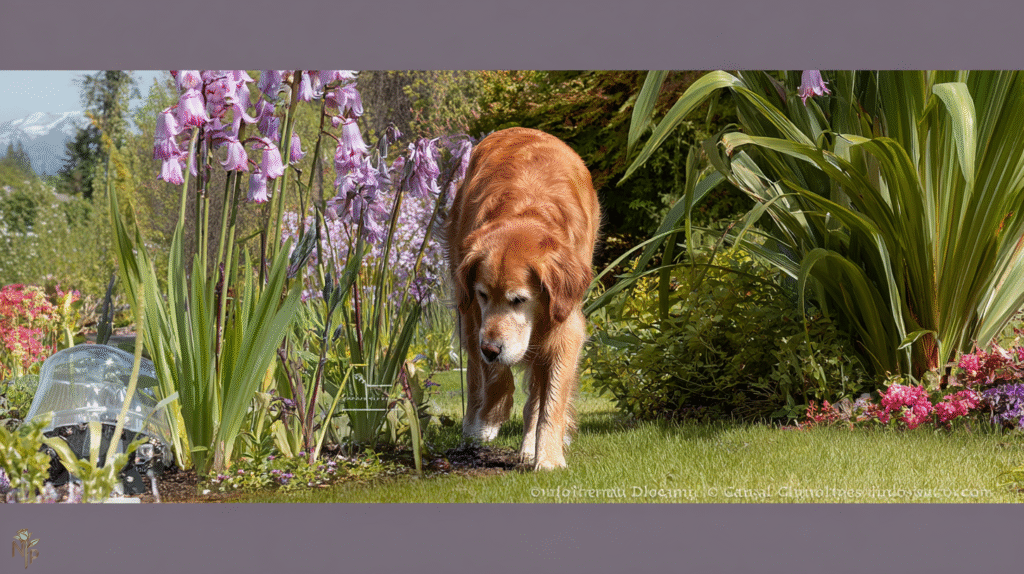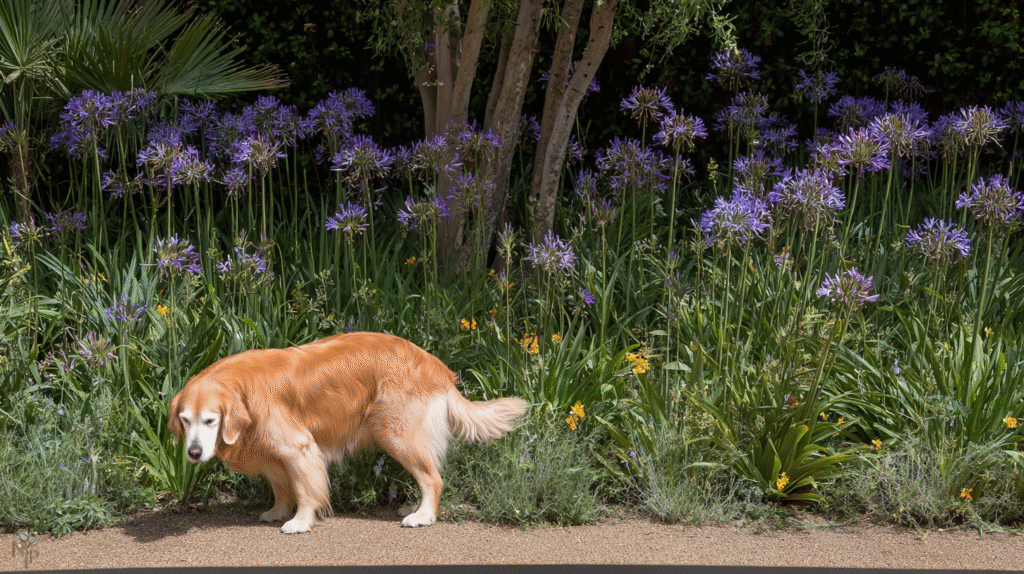The emergency vet bill was $1,847. My golden retriever, Buddy, had eaten exactly three leaves from my sago palm while I was inside making coffee. Three leaves. That’s all it took to nearly kill him.
I’d owned that sago palm for two years. It sat right by the patio where Buddy loved to sunbathe. I had no idea it was basically a death trap disguised as a tropical plant. The vet told me we were lucky — if I’d waited another hour to bring him in, he probably wouldn’t have made it.
That terrifying weekend sent me down a research spiral about toxic plants. Turns out, my yard and house were full of them. Now, three years later, I’ve become that person who warns every dog owner about their plants. Here’s everything I learned the hard way about identifying the common plants that could seriously harm or kill your dog.

The Deadly Dozen: Plants That Can Kill
Let’s start with the worst offenders — plants that can be fatal even in small amounts:
Sago Palm (Cycas revoluta) The one that almost killed Buddy. Every part is poisonous, but the seeds are the worst. Causes liver failure fast. Survival rate even with treatment is only 50%. I removed mine the day Buddy came home from the hospital.
Oleander Beautiful flowers, deadly plant. One leaf can kill a large dog. Even the water in a vase with oleander is toxic. Common in warm climates as landscaping. My neighbor had a whole hedge of it — had being the key word.
Foxglove Those pretty bell-shaped flowers contain cardiac glycosides. Affects the heart immediately. Often found in cottage gardens. I pulled all mine after the sago palm incident.
Azaleas and Rhododendrons Just a few leaves cause vomiting, drooling, and potentially coma. These are EVERYWHERE in landscaping. I counted twelve on my street alone.
Castor Bean Contains ricin. Yes, that ricin. Extremely toxic seeds. Sometimes grown as an ornamental annual. Absolutely not worth the risk.
Autumn Crocus Not your spring crocus — this one’s much worse. Can cause multiple organ failure. Symptoms might not show for days, making it extra dangerous.
The Backyard Dangers Hiding in Plain Sight
These common plants might already be in your yard:
Tulips and Daffodils The bulbs are the toxic part. My beagle dug up and ate tulip bulbs one spring — cue frantic vet visit and induced vomiting. Now I only plant them in raised beds she can’t access.
Lily of the Valley Those sweet little bells are cardiac toxins. Grows in shady spots, spreads everywhere. I spent a whole weekend removing a patch that came with our house.
Yew Common in landscaping. The berries look tempting to dogs, but the seed inside is deadly. The foliage is toxic too. That “privacy hedge” might be dangerous.
English Ivy Causes vomiting, abdominal pain, hypersalivation, and diarrhea. It’s growing on every other fence in my neighborhood. I’ve removed miles of it.
Hydrangea Those big beautiful blooms contain cyanide. Usually not fatal but causes vomiting and lethargy. I kept mine but fenced them off completely.
Indoor Plants That Pose Risks
Your houseplants might be problems too:
Dieffenbachia (Dumb Cane) Causes intense oral irritation and swelling. Can block airways. My friend’s puppy needed emergency treatment after chewing one leaf.
Philodendron Popular, easy-care, and toxic. Causes oral irritation and vomiting. I rehomed all mine to friends without pets.
Pothos Another “easy” houseplant that’s not dog-friendly. Similar effects to philodendron. Hanging baskets aren’t safe — dogs eat fallen leaves.
Peace Lily Despite the peaceful name, causes mouth burning and vomiting. Not as toxic as true lilies but still dangerous.
Snake Plant Causes nausea and vomiting. Usually not fatal but why risk it? I moved all mine to rooms the dogs can’t access.
The Sneaky Toxic Plants You Wouldn’t Suspect
Some toxic plants surprised me:
Tomato Plants The fruit is fine when ripe, but the leaves and stems contain solanine. My lab ate tomato leaves and got pretty sick. Now the vegetable garden is fully fenced.
Rhubarb The stems we eat are okay, but the leaves are toxic. Can cause kidney failure. Found this out when Buddy sampled my rhubarb patch.
Avocado The pit, skin, and leaves contain persin. Toxic to dogs. That trendy avocado tree? Maybe reconsider if you have dogs.
Grapes and Raisins Okay, not technically plants, but grape vines in the garden are dangerous. Even small amounts of grapes can cause kidney failure in dogs.
How to Identify Unknown Plants
After my sago palm scare, I became obsessed with identifying every plant:
Use apps: PlantNet, PictureThis, or Google Lens. I photograph every unknown plant now. Takes seconds, could save your dog’s life.
Check reliable sources: ASPCA’s toxic plant database is my go-to. Search any plant before buying or keeping it.
When in doubt: If you can’t identify it with certainty, remove it or fence it off. Not worth the risk.
Label everything: I keep plant tags and write names on popsicle sticks. Helps in emergencies when vets need to know exactly what was eaten.
Creating a Dog-Safe Garden
After removing toxic plants, here’s what I planted instead:
Safe alternatives that look great:
- Roses (thorns are a concern but not toxic)
- Sunflowers
- Zinnias
- Marigolds
- Snapdragons
- Petunias
Dog-friendly herbs:
- Basil
- Thyme
- Oregano
- Rosemary
Safe shrubs:
- Camellia
- Bottlebrush
- Blueberry bushes

What to Do If Your Dog Eats a Toxic Plant
Time is critical. Here’s my emergency protocol:
- Don’t panic but act fast
- Take a photo of the plant and what’s been eaten
- Call pet poison control: ASPCA (888) 426-4435 or Pet Poison Helpline (855) 764-7661
- Don’t induce vomiting unless directed — some toxins cause more damage coming back up
- Get to emergency vet immediately
- Bring plant sample if possible
That photo I took of the sago palm helped the vet start treatment immediately. Every minute counted.
Prevention Strategies That Actually Work
Fence off danger zones: Physical barriers work better than training. My dogs are smart, but not “avoid-the-pretty-plant-that-smells-interesting” smart.
Remove highest risk plants: After Buddy’s near-death experience, I removed all extremely toxic plants. Peace of mind is worth more than any plant.
Supervise outdoor time: I used to let the dogs out while I made coffee. Not anymore. Those few unsupervised minutes almost cost Buddy his life.
Train “leave it” command: Essential but not foolproof. Works best as backup to physical barriers.
Regular yard patrol: I walk the yard weekly looking for volunteer plants, mushrooms, or anything new that’s sprouted.
The Reality Check
I spent years creating a beautiful garden, only to rip half of it out after Buddy’s sago palm incident. Was it worth it? Absolutely. Every time I see him napping in his now-safe yard, I remember that vet saying we almost lost him.
My garden might be less exotic now, but it’s more peaceful. I don’t panic every time the dogs go outside. Friends with dogs actually feel comfortable visiting. The trade-off — some beautiful but deadly plants for my dog’s safety — wasn’t even a question once I knew the risks.
That $1,847 vet bill taught me an invaluable lesson: no plant is worth risking your dog’s life. Now I research every plant before it comes near my property. I’ve become the neighborhood’s unofficial toxic plant identifier. And you know what? I’m okay with that. If my paranoia saves even one dog from going through what Buddy did, it’s worth being the crazy plant lady.
Take an hour this weekend. Walk your yard. Identify everything. Remove or fence off anything toxic. Your dog’s life might depend on it. Trust me — I learned this the terrifying, expensive, almost-tragic way. Don’t make my mistake. 🐕







